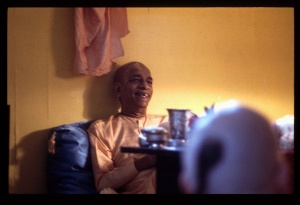CC Adi 7.133: Difference between revisions
m (1 revision(s)) |
No edit summary |
||
| Line 1: | Line 1: | ||
{{ | [[Category:Sri Caitanya-caritamrta - Adi-lila Chapter 07|C133]] | ||
<div style="float:left">'''[[Sri Caitanya-caritamrta|Śrī Caitanya-caritāmṛta]] - [[CC Adi|Ādi-līlā]] - [[CC Adi 7|Chapter 7: Lord Caitanya in Five Features]]'''</div> | |||
<div style="float:right">[[File:Go-previous.png|link=CC Adi 7.132|Ādi-līlā 7.132]] '''[[CC Adi 7.132|Ādi-līlā 7.132]] - [[CC Adi 7.134|Ādi-līlā 7.134]]''' [[File:Go-next.png|link=CC Adi 7.134|Ādi-līlā 7.134]]</div> | |||
{{CompareVersions|CC|Adi 7.133|CC 1975|CC 1996}} | |||
{{RandomImage}} | |||
==== TEXT 133 ==== | ==== TEXT 133 ==== | ||
<div | <div class="verse"> | ||
ei mata pratisūtre sahajārtha chāḍiyā | :ei mata pratisūtre sahajārtha chāḍiyā | ||
gauṇārtha vyākhyā kare kalpanā kariyā | :gauṇārtha vyākhyā kare kalpanā kariyā | ||
</div> | </div> | ||
| Line 12: | Line 16: | ||
==== SYNONYMS ==== | ==== SYNONYMS ==== | ||
<div | <div class="synonyms"> | ||
ei | ''ei mata''—like this; ''prati-sūtre''—in every ''sūtra'', or aphorism, of the ''Vedānta-sūtra''; ''sahaja-artha''—the clear, simple meaning; ''chāḍiyā''—giving up; ''gauṇa-artha''—indirect meaning; ''vyākhyā''—explanation; ''kare''—he makes; ''kalpanā kariyā''—by imagination. | ||
</div> | </div> | ||
| Line 19: | Line 23: | ||
==== TRANSLATION ==== | ==== TRANSLATION ==== | ||
<div | <div class="translation"> | ||
“To prove their philosophy, the members of the Māyāvāda school have given up the real, easily understood meaning of the Vedic literature and introduced indirect meanings based on their imaginative powers.” | “To prove their philosophy, the members of the Māyāvāda school have given up the real, easily understood meaning of the Vedic literature and introduced indirect meanings based on their imaginative powers.” | ||
</div> | </div> | ||
| Line 26: | Line 30: | ||
==== PURPORT ==== | ==== PURPORT ==== | ||
<div | <div class="purport"> | ||
Unfortunately, the Śaṅkarite interpretation has covered almost the entire world. Therefore there is a great need to present the original, easily understood natural import of the Vedic literature. We have therefore begun by presenting Bhagavad-gītā As It Is, and we propose to present all the Vedic literature in terms of the direct meaning of its words. | Unfortunately, the Śaṅkarite interpretation has covered almost the entire world. Therefore there is a great need to present the original, easily understood natural import of the Vedic literature. We have therefore begun by presenting [[Bhagavad-gita As It Is (1972)|''Bhagavad-gītā As It Is'']], and we propose to present all the Vedic literature in terms of the direct meaning of its words. | ||
</div> | </div> | ||
__NOTOC__ | |||
<div style="float:right; clear:both;">[[File:Go-previous.png|link=CC Adi 7.132|Ādi-līlā 7.132]] '''[[CC Adi 7.132|Ādi-līlā 7.132]] - [[CC Adi 7.134|Ādi-līlā 7.134]]''' [[File:Go-next.png|link=CC Adi 7.134|Ādi-līlā 7.134]]</div> | |||
__NOTOC__ | |||
__NOEDITSECTION__ | |||
Revision as of 11:30, 12 July 2021

A.C. Bhaktivedanta Swami Prabhupada
TEXT 133
- ei mata pratisūtre sahajārtha chāḍiyā
- gauṇārtha vyākhyā kare kalpanā kariyā
SYNONYMS
ei mata—like this; prati-sūtre—in every sūtra, or aphorism, of the Vedānta-sūtra; sahaja-artha—the clear, simple meaning; chāḍiyā—giving up; gauṇa-artha—indirect meaning; vyākhyā—explanation; kare—he makes; kalpanā kariyā—by imagination.
TRANSLATION
“To prove their philosophy, the members of the Māyāvāda school have given up the real, easily understood meaning of the Vedic literature and introduced indirect meanings based on their imaginative powers.”
PURPORT
Unfortunately, the Śaṅkarite interpretation has covered almost the entire world. Therefore there is a great need to present the original, easily understood natural import of the Vedic literature. We have therefore begun by presenting Bhagavad-gītā As It Is, and we propose to present all the Vedic literature in terms of the direct meaning of its words.